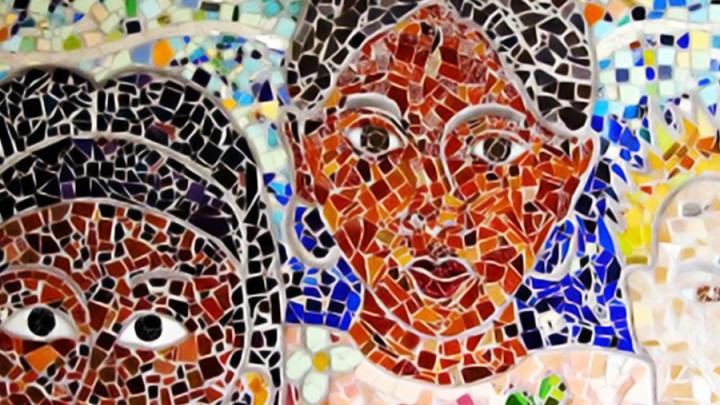
Culturally Relevant Student Experiences are at the Forefront of the East-UR Partnership
School districts across the country are paying more attention to diversifying K-12 curricula and bringing more culturally relevant content into classrooms, especially as the spotlight is now on Connecticut to become the first state in the nation to require high schools to offer Black and Latino studies by fall 2022. But culturally responsive teaching has been at the forefront of Rochester’s East High School, where teachers have been creating classroom lessons and experiences focused on equity, including racial and social justice, for years.
For the past five years through the school’s unique partnership with the University of Rochester with Superintendent Shaun Nelms ‘04W (MS), ‘13W (EdD) at the helm, East has been delivering instruction that is culturally relevant, responsive, and sustaining. And East’s approach to culturally responsive-sustaining education, which is grounded in Gloria Ladson-Billings’ early work on Culturally Relevant & Responsive Pedagogy (CRRP) and referred to as CRRP by East staff, is helping to pave the way to success for engaged students in the Upper & Lower Schools, as graduation rates, academic scores, and school attendance continue to rise and dropout rates and suspensions are on the decline.
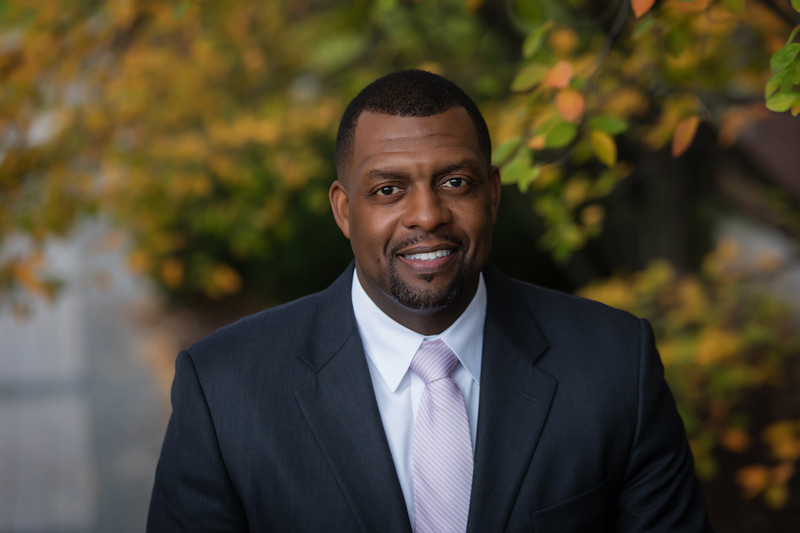 “Our teachers, not only at East but in schools across the country, have more diverse classrooms today,” says Nelms, associate professor and the William & Sheila Konar Director of the Center for Urban Education Success (CUES) at the University of Rochester’s Warner School of Education. “Schools are filled with students with different backgrounds and experiences, so instruction must build on these individual and cultural experiences and the prior knowledge that they bring to the classroom. Culturally responsive teaching is pertinent—now more than ever—because content needs to reflect and embrace our worldwide, multi-cultural community, so that school is a place where all scholars are valued, cared for, and respected for their full selves.”
“Our teachers, not only at East but in schools across the country, have more diverse classrooms today,” says Nelms, associate professor and the William & Sheila Konar Director of the Center for Urban Education Success (CUES) at the University of Rochester’s Warner School of Education. “Schools are filled with students with different backgrounds and experiences, so instruction must build on these individual and cultural experiences and the prior knowledge that they bring to the classroom. Culturally responsive teaching is pertinent—now more than ever—because content needs to reflect and embrace our worldwide, multi-cultural community, so that school is a place where all scholars are valued, cared for, and respected for their full selves.”
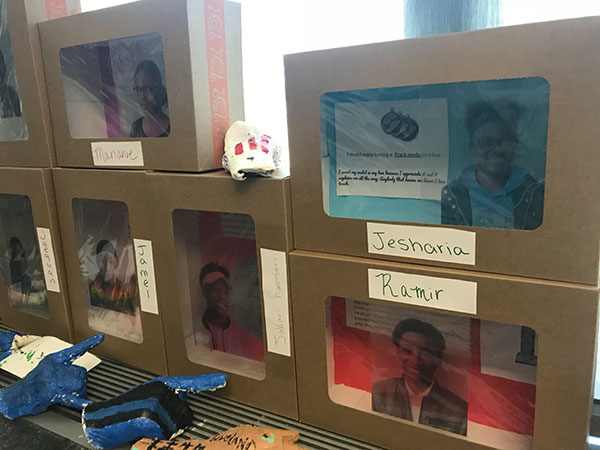 At East, staff acknowledge and honor the strengths of their scholars’ diverse experiences, backgrounds, and interests. They see these as opportunities for enhancing teaching and learning in their classrooms. CRRP at East recognizes student identities, including gender, ability/disability, religion, sexual orientation, socioeconomic status, race, ethnicity, language and nationality, and takes these into account to enhance teaching and learning. The goal is to create a safe school environment where all individuals are able to voice opinions, share ideas, listen to, and be heard and respected by others. Research confirms that this type of learning environment also supports greater academic success.
At East, staff acknowledge and honor the strengths of their scholars’ diverse experiences, backgrounds, and interests. They see these as opportunities for enhancing teaching and learning in their classrooms. CRRP at East recognizes student identities, including gender, ability/disability, religion, sexual orientation, socioeconomic status, race, ethnicity, language and nationality, and takes these into account to enhance teaching and learning. The goal is to create a safe school environment where all individuals are able to voice opinions, share ideas, listen to, and be heard and respected by others. Research confirms that this type of learning environment also supports greater academic success.
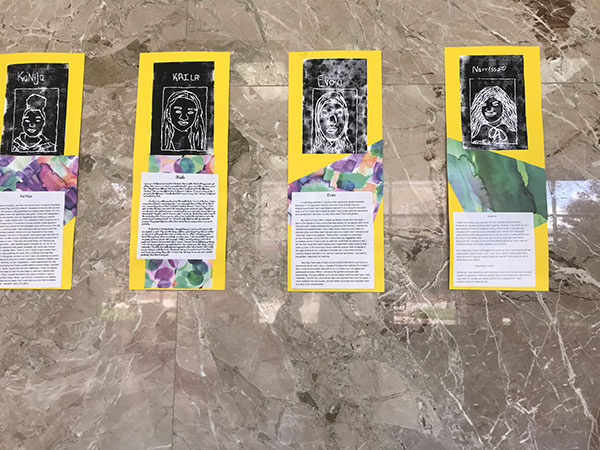 Aligning with the central goals of CRRP, the framework at East has five facets: relevant curriculum; responsive practices; positive social and emotional development; complex and critical thinking; and empowerment, self-efficacy and initiative. When the University began serving as the educational partnership organization (EPO) for East, due to the school’s long history of failure to meet New York State Education Department benchmarks, East staff engaged with consultant Sonia James-Wilson, owner of Catalyst Research and Development, to help lead this charge of infusing CRRP into all aspects of the school’s culture—both inside and outside of the curriculum. Initially, James-Wilson established a weeklong summer institute, which she continues to hold annually, and has since expanded her CRRP work to also include an ongoing professional development series, interdepartmental reviews and assistance with designing curricula, and consulting (both one-on-one and small group) with staff.
Aligning with the central goals of CRRP, the framework at East has five facets: relevant curriculum; responsive practices; positive social and emotional development; complex and critical thinking; and empowerment, self-efficacy and initiative. When the University began serving as the educational partnership organization (EPO) for East, due to the school’s long history of failure to meet New York State Education Department benchmarks, East staff engaged with consultant Sonia James-Wilson, owner of Catalyst Research and Development, to help lead this charge of infusing CRRP into all aspects of the school’s culture—both inside and outside of the curriculum. Initially, James-Wilson established a weeklong summer institute, which she continues to hold annually, and has since expanded her CRRP work to also include an ongoing professional development series, interdepartmental reviews and assistance with designing curricula, and consulting (both one-on-one and small group) with staff.
Often referred to as Dr. Sonia by East staff, James-Wilson has served as a guiding light for many at East, including social studies teacher Quinton Mitchell ’13 (BS), ‘14W (MS) and literacy teacher Alexa Tarantino.
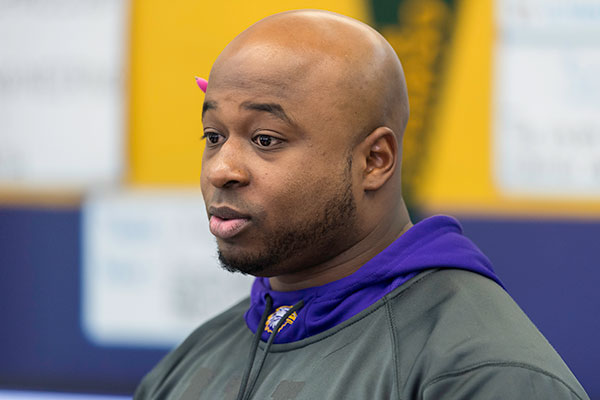 “Some consultants come and go, but Dr. Sonia has been here for a while,” says Mitchell as he recounts his first summer institute with her. “She made herself available, and I latched onto it. In order to do this work, you have to be willing to devote the time to it.”
“Some consultants come and go, but Dr. Sonia has been here for a while,” says Mitchell as he recounts his first summer institute with her. “She made herself available, and I latched onto it. In order to do this work, you have to be willing to devote the time to it.”
Mitchell, who completed the social studies education and Urban Teaching & Leadership programs at Warner, began his career at East’s Lower School (Grades 6-8) at the start of the EPO, both as a young and early teacher, ready to plan, design curriculum, and navigate managing his classroom—all the things you have to become comfortable with as a novice teacher. Now in his sixth year of teaching, Mitchell has checked off those early boxes and is able to take a step back and reflect on how he can better refine his practice. Most recently, Mitchell joined the school’s new CRRP subcommittee that continues to build CRRP not only in the curriculum, but to all areas of the school culture, including extracurricular activities and events. 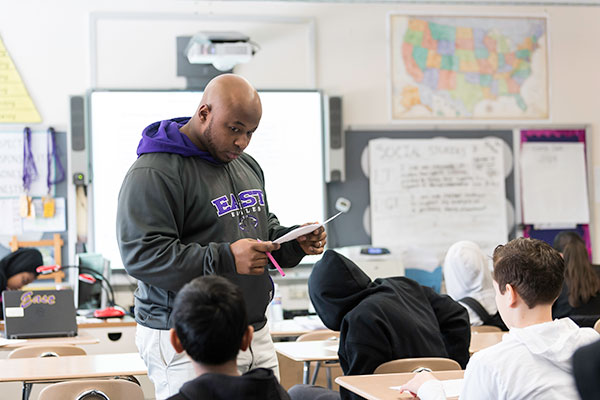
In his seventh-grade social studies classroom, Mitchell is mindful of delivering meaningful instruction that is culturally relevant, including the current events impacting his students’ lives. He also aims to provide positive representations of his students in the curriculum, incorporate student choice, and hone students’ analytical and critical thinking skills—all while always helping them to look at and understand the past-present connections of the history content he teaches.
Equally important to the historical connections, Mitchell found, has been the visual connections, like ‘before and after’ images of historical events, charts, etc., to hook students. “Once they are hooked,” he explains, “it’s easier to frame things and guide them into seeing the full picture, and give them a chance to make their own evaluation, between weighing the positives and negatives, and really think about what we can do to make things better for everyone.”
For example, with his Western expansion unit, Mitchell is able to help students relate this era of U.S. history to other present-day forms of gentrification in Rochester, a hotspot for what’s taking place in cities across the country. Providing a visual standpoint, he adds, is a way to build students’ understanding beyond a simple definition—to seeing things from all sides. And by looking at different cultural groups, he hopes that students are able to come to realize that the country’s narrative about progressing and getting better as a country does not necessarily apply to everyone.
“I think we are really able to get away from the way things have been traditionally taught in the classroom to really give students a more realistic picture of what has happened, and to learn from the past and use that to inform the things we are still experiencing,” Mitchell says, “to really think more deeply about why Rochester is the way it is today.”
Other subject areas also include opportunities to shape students’ understanding of racial and social justice and equity. CRRP lends itself well to other content areas such as literacy at East, where every scholar in grades 6-9 takes an English language arts (ELA) class as well as a class in literacy through the EPO model. East is the only Rochester city school to offer literacy as a stand-alone, required course for all students, in grades 6-9, in addition to ELA.
East literacy teacher Tarantino created a niche for mixing art with literacy in her classroom instruction at East’s Lower School. And this unique pairing is where her relationship with James-Wilson began because she enrolled in one of her CRRP training workshops, and shortly after they teamed up to integrate arts into instructional units as a way to teach students literacy skills and content. This has resulted in more engaging classrooms for students of all backgrounds.
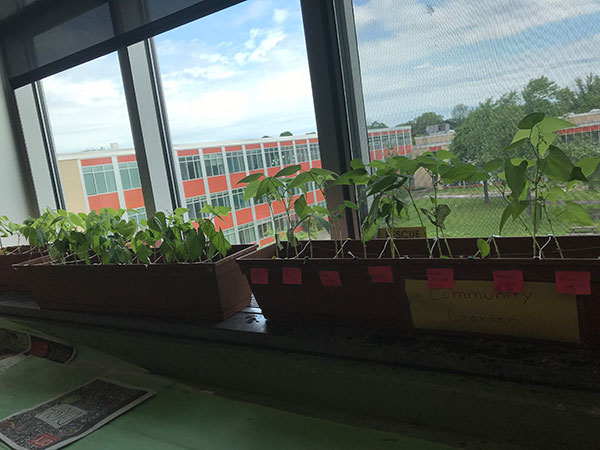 For a class reading of the book Seedfolks by Paul Fleischman, for example, Tarantino paired art with a writing piece about the story, which is about a diverse community coming together to create a vibrant community garden in an immigrant neighborhood of Cleveland, Ohio. Tarantino and her students created their own community garden that they nurtured and watched grow on their classroom windowsill and created self-portraits, resembling the 13 characters of the book, using a stamping technique to print facial features, and then wrote about their projects.
For a class reading of the book Seedfolks by Paul Fleischman, for example, Tarantino paired art with a writing piece about the story, which is about a diverse community coming together to create a vibrant community garden in an immigrant neighborhood of Cleveland, Ohio. Tarantino and her students created their own community garden that they nurtured and watched grow on their classroom windowsill and created self-portraits, resembling the 13 characters of the book, using a stamping technique to print facial features, and then wrote about their projects. Self-exploration and identity are a big part of Tarantino’s work around CRRP with her class. They begin the school year with a unit on memoirs, which she refers to as a “roots & branches” project, where they look at their identities—who they are, what makes them tick, and what’s important to them—and then create a slideshow presentation, often incorporating pictures and representational pieces, about their lives to share with the class. This then leads them to writing their own memoirs.
Self-exploration and identity are a big part of Tarantino’s work around CRRP with her class. They begin the school year with a unit on memoirs, which she refers to as a “roots & branches” project, where they look at their identities—who they are, what makes them tick, and what’s important to them—and then create a slideshow presentation, often incorporating pictures and representational pieces, about their lives to share with the class. This then leads them to writing their own memoirs.
“A lot of it ends up being about identity and family and where they came from and things like that,” says Tarantino. “Some writers go even deeper and some writers keep it surface level—it really depends on the student—but that kicks off the whole school year and from there we kind of go into our social justice units.”
Tarantino, like Mitchell, sees the value of giving her students a lot of choice, a big part of CRRP. For the social justice units, her students pick what topics and issues of their communities and cultures to research, making connections between current events, so it’s very self-directed. Students then write professional letters to local officials around social justice issues they believe should be addressed in their city.
She says, “I think being engaged in what you’re learning about is really important, and when it has to do with you and your life, that only enhances the engagement. It’s all real-world things that are happening to them and around them.”
As for what Tarantino has learned about this work, she’s found that eighth-graders can be a lot more powerful with words than she once thought.
“Giving them choice has really shown me a lot of how that engagement piece really plays into their education because, especially in middle school, you’re not necessarily aware of what’s going on around you, or you may not necessarily care at that age,” she says. “It’s more of the right here, right now … the ‘me, me, me’ but by using that to play on, to teach through, I think it helps a lot. The identity, the choice—all of that.”
Both Tarantino and Mitchell have witnessed CRRP moving to the forefront at East the past five years.
Embracing and celebrating equity and diversity in East’s classrooms
Impacting K-12 Urban Education in Rochester and Beyond
A team of East and CUES staff has launched a new website, called Elevated Educator, to share some of these emerging units and lessons more broadly. The site makes a limited number of these teaching materials publicly available to help meet the growing needs of teachers across the country in delivering unit plans, from grades 6 to 12, that are culturally relevant and responsive to students of color.
“This model of capturing, documenting, and sharing engaging and culturally relevant lessons is a testament to the University of Rochester’s commitment to moving this work beyond the walls of East,” says Susan Meier, curriculum and instructional specialist at the Warner School and the former chief academic officer for the East EPO, who was instrumental in vetting and pulling the materials together for the new site. “The Center will continue to leverage the knowledge and lessons learned and gained at East to impact K-12 urban schools in Rochester and nationwide.”
According to Meier, many teachers want to see examples of what CRRP looks like. “One of our goals is to provide usable examples that will help teachers from anywhere see that teaching through this lens is doable, and also powerful and exciting,” she adds.
The site, designed by Chib Designed It, features a vibrant directory that allows visitors to sort materials by grade, subject, and language in order to learn more about and download unit plans for free. The team plans to regularly upload new unit plans to eventually provide the span of grade levels and content areas with examples. Visit the website: www.elevatededucator.org.
Together with community partners and local school districts, CUES is building new anti-racist instruction to explore Rochester’s history with race relations. The initiative will be implemented in Monroe County classrooms as early as this spring, beginning with grades 8, 11, and 12 and aligning with the U.S. history curricula and New York State standards. Learn more about the instruction centered on equity underway for Monroe County schools.
About the University of Rochester/East EPO Partnership
The University of Rochester, as the Educational Partnership Organization (EPO) for East High School, has assumed full management responsibilities for East, effective July 2015. The new East (http://www.rcsdk12.org/east) consists of a Lower School (grades 6-8) and an Upper School (grades 9-12), and aims to prepare all students for a successful transition into adulthood. A comprehensive community school with a robust set of services to support its diverse students, East offers a strong academic and career preparation program, including a daily advisory program and a full complement of athletic and extra-curricular activities that support and engage students.